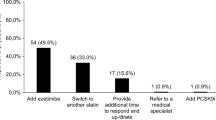Abstract
Objective:To study knowledge of and adherence to National Cholesterol Education Program Adult Treatment Panel (ATP) guidelines among primary care physicians.
Design:Cross-sectional telephone survey.
Setting:New York State primary care practitioners; survey conducted November 1988-January 1989.
Participants:Physicians in general practice, family practice, internal medicine without subspecialty, and cardiology who reported ≥10 bours/week of clinical practice (n=329; response rate = 63%).
Interventions:None.
Measurements and main results:While 84% of physicians bad beard of the ATP guidelines, gaps in knowledge and inconsistencies between ATP recommendations and clinical practices were found. Although the ATP guidelines recommend six months of dietary therapy before starting drug treatment, 41% of physicians would initiate drug treatment for a healthy 40-year-old man with total cbolesterol of 7.8 mmol/L (300 mg/dl) either at the initial visit or after one month of lipid-lowering diet. Multivariate analysis of a 24-item knowledge scale revealed that less knowledgeable physicians were more likely to be older, lack board certification, and have a specialty other than cardiology (p<0.01). Less knowledgeable physicians were also more likely to consider drug company literature and drug company representatives very useful sources of information about cholesterol (p=0.02).
Conclusion:This study suggests that bard-to-reach physician groups may require special efforts to communicate consensus guidelines of major importance to clinical practice.
Similar content being viewed by others
References
National Institutes of Health Consensus Development Conference statement. Lowering blood cholesterol to prevent heart disease. JAMA. 1985;253:2080-6.
Lenfant C. A new challenge for America: the National Cholesterol Education Program. Circulation. 1986;73:855–6.
The Expert Panel. Report of the National Cholesterol Education Program Expert Panel on detection, evaluation, and treatment of high blood cholesterol in adults. Arch Intern Med. 1988;148:36–69.
Schucker B, Wittes JT, Cutler JA, et al. Change in physician perspective on cholesterol and heart disease. Results from two national surveys. JAMA. 1987;258:3521–6.
Lipid Research Clinics Program. The Lipid Research Clinics coronary primary prevention trial results. I. Reduction in incidence of coronary heart disease. JAMA. 1984;251:351–64.
Lipid Research Clinics Program. The Lipid Research Clinics coronary primary prevention trial results. II. The relationship of reduction in incidence of coronary heart disease to cholesterol lowering. JAMA. 1984;251:365–74.
Shea S, Basch CE, Zybert P. Correlates of internists’ practices in caring for patients with elevated serum cholesterol. Am J Health Promotion. In press.
SPSS Incorporated. SPSS-X users’ guide. 3rd ed. Chicago: SPSS, Inc., 1988.
Bandura A. Self-efficacy: toward a unifying theory of behavioral change. Psychol Rev. 1977;84:191–215.
Stross JK, Harlan WR. The dissemination of new medical information. JAMA. 1979;241:2622–4.
Stross JK, Harlan WR. Dissemination of relevant information on hypertension. JAMA. 1981;246:360–2.
Hlatky MA, Cotugno H, O’Connor C, Mark DB, Pryor DB, Califf RM. Adoption of thrombolytic therapy in the management of acute myocardial infarction. Am J Cardiol. 1988;61:510–4.
Lomas J, Anderson GM, Domnick-Pierre K, et al. Do practice guidelines guide practice? The effect of a consensus statement on the practice of physicians. N Engl J Med. 1989;321:1306–11.
Manoff RK. Social marketing. New York: Praeger, 1985.
Author information
Authors and Affiliations
Additional information
Received from the Department of Medicine and the Division of Epidemiology and Sociomedical Sciences, School of Public Health, Columbia University Health Sciences Division, New York, New York.
Supported in part by a Grant-in-aid from the American Heart Association, New York City Affiliate.
Rights and permissions
About this article
Cite this article
Shea, S., Gemson, D.H. & Mossel, P. Management of high blood cholesterol by primary care physicians. J Gen Intern Med 5, 327–334 (1990). https://doi.org/10.1007/BF02600401
Issue Date:
DOI: https://doi.org/10.1007/BF02600401



